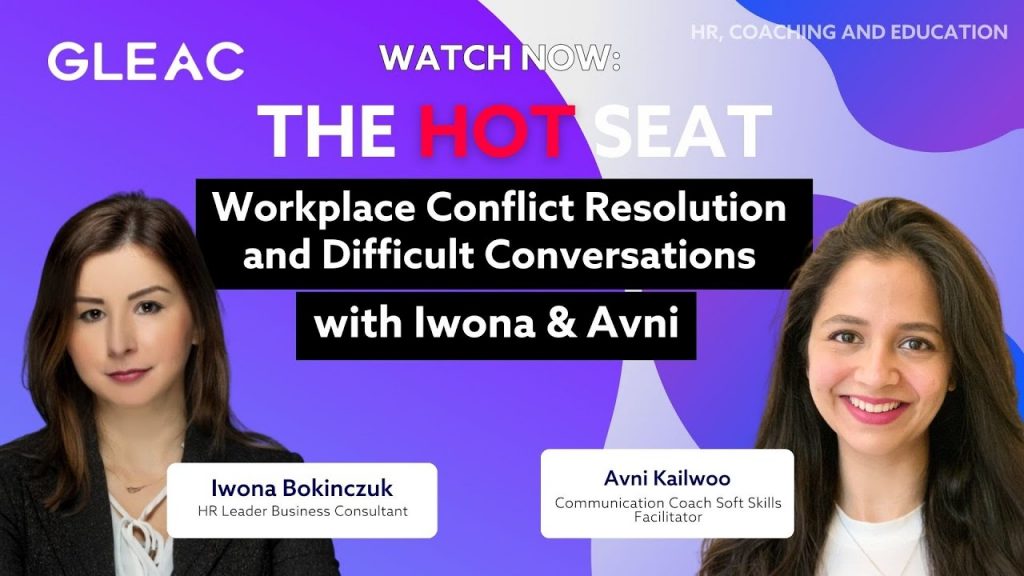In today’s fast-paced and diverse workplaces, conflicts are almost inevitable. Misunderstandings, differences in perspective, and various other factors can lead to tensions between employees. To shed light on effective conflict resolution and communication strategies, we sat down with two experts, Avni and Iwona, who come from different professional backgrounds but share a common goal—solving workplace conflicts.
Meet the Experts
First, we have Avni, a communication coach and soft skills consultant with over 11 years of experience in the industry. She started her career as a software engineer but later realized her passion for improving workplace dynamics and communication.
Iwona, our second expert, has a diverse background that spans across administrative, marketing, operations, and human resources roles. With her extensive HR and recruitment experience, Iwona offers valuable insights into conflict resolution.
Understanding the Roots of Conflict
Before delving into conflict resolution strategies, it’s essential to grasp the sources of workplace conflicts. Avni and Iwona both emphasized that conflicts often arise due to:
- Lack of Empathy: Failure to understand and empathize with coworkers’ perspectives and feelings can lead to misunderstandings and conflicts.
- Bad Communication Skills: Ineffective communication, which includes verbal and non-verbal aspects, contributes significantly to workplace conflicts. This can involve tone of voice, body language, and facial expressions.
- Stereotypes and Past Experiences: Past negative experiences or stereotypes can cloud individuals’ judgment and lead to misunderstandings.
The Role of HR in Conflict Resolution
Ivana, with her HR expertise, stressed the importance of HR departments in conflict resolution. HR plays a crucial role in:
- Understanding People: HR professionals need to comprehend the dynamics of their organizations and employees. This involves understanding individual departments and roles within the organization.
- Setting Boundaries: Establishing clear communication and operational procedures is essential. Procedures create a culture that helps mitigate conflicts and promote collaboration.
- Supporting Rebuilding of Relationships: HR should assist in rebuilding relationships between conflicting parties. Rather than immediately resorting to relocation or disciplinary action, efforts should be made to resolve issues through communication and training.
Communication Strategies for Conflict Resolution
Avni shared three fundamental communication strategies for conflict resolution:
- Active Listening: Actively listening to the other party demonstrates respect and can help uncover underlying issues. Paying attention to non-verbal cues like facial expressions and body language is equally important.
- Non-Verbal Communication: Effective communication extends beyond words. Non-verbal cues, such as tone of voice, gestures, and facial expressions, significantly impact how a message is received.
- How You Say It Matters: The way you convey your message is as crucial as the message itself. Tone of voice, volume, and speed all play a part in effective communication. Mirroring the other person’s body language and verbal style can enhance understanding.
Addressing the “What” and “How” of Conflict
Iwona added that understanding the “what” and “how” aspects of conflict is essential:
- Exploring the “What”: Delve into the root causes of the conflict. Personalities, experiences, and triggers can influence how conflicts develop. Identifying these factors can help in finding effective solutions.
- Mastering the “How”: Assess your own emotional state and maintain a neutral demeanor when dealing with conflicts. Behavioral development training or Neuro-Linguistic Programming (NLP) can be valuable tools for HR professionals.
- Finding Common Ground: HR should strive to find common ground between conflicting parties. It’s not about immediate solutions but gradually building understanding and resolving issues over time.


Conclusion
Workplace conflicts are complex and often arise from miscommunication, stereotypes, and past experiences. HR departments play a crucial role in understanding and addressing these issues. Effective conflict resolution strategies involve active listening, considering non-verbal communication, and mastering the art of “what” and “how” when dealing with conflicts.
By implementing these strategies, organizations can foster better communication, mitigate conflicts, and create a more harmonious and productive work environment. Whether you’re an HR professional or someone dealing with workplace conflicts, the insights from Avni and Ivana can guide you towards better conflict resolution and improved communication.
Interested in enhancing your skills with the guidance of these distinguished mentors?
Book a time with Iwona here: https://www.gleac.com/mentors/iwona-bokinczuk
and with Avni here: https://www.gleac.com/mentors/avni-kailwoo

